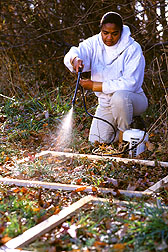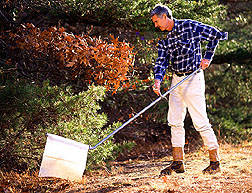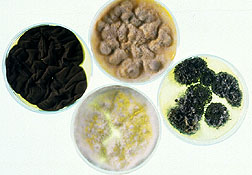Tackling Ticks That Spread Lyme Disease
If just thinking about ticks makes you squeamish, then you'll want to stay away from Dolores Hill's lab in Beltsville, Maryland. There, in tiny glass vials and Styrofoam containers, Hill keeps several hundred blacklegged deer ticks, scientifically known as Ixodes scapularis.
A parasitologist for USDA's Agricultural Research Service, Hill collects the blood-sucking ticks as part of a 5-year project to biologically control the pests with microscopic roundworms, called nematodes.
Hill's goal is to formulate the worms into a product that could be sprayed in residential areas, like backyards, where homeowners can be bitten by ticks infected with Borrelia burgdorferi, the bacterium that causes Lyme disease. In 1996, the Centers for Disease Control in Atlanta, Georgia, received more than 16,000 reports of the tickborne disease. Ninety percent came from the northeastern United States, where I. scapularis is most prevalent.
Humans aren't the tick's first choice of hosts. But suburban sprawl into wooded habitat has placed people in closer contact with white-tailed deer, the adult ticks' natural host and chief transportation source.
"If deer are feeding on azalea bushes at the back of your yard, that's where a female tick may drop off and lay her eggs. So that's also where you'd want to spray the nematodes," explains Hill, who is with the ARS Parasite Biology and Epidemiology Laboratory.
Her top tick-fighting recruits include nine strains of the nematode species Steinernema and four strains of Heterorhabditis. Both are well known to science, she says. While harmless to higher vertebrates (humans and livestock, for instance), the nematodes are renowned for attacking many insects pests.
"But few people have really looked closely at whether these nematodes will infect and kill ticks," says Hill. Ticks aren't insects, but arachnids--like mites, scorpions, and spiders.
Her studies show the worms may be most effective against adult female ticks, which lay as many 2,000 eggs. "If you find an engorged adult deer tick on you," says Hill, "it's most likely a female taking a blood meal so she can reproduce."
But tiny tick offspring are as much of a menace as grown adults.
This is especially true of the nymphs, a juvenile stage about the size of a pepper flake. They are more likely than adult ticks to transmit Lyme disease to humans, says Hill. Their tiny size allows nymphs to feed longer without being detected, giving them enough time to pass the Lyme bacterium into their host's bloodstream.
One tick-fighting strategy is to spray an infested area with an appropriate insecticide or acaricide. "But many people don't want to have those chemicals sprayed in their backyards," notes Hill.
Many of the tick-killing chemicals are toxic, and their use may have adverse environmental effects. They may also require repeat applications as new ticks are brought in by deer and other animals searching for food.
The nematodes could offer the advantage of sticking around longer, taking up residence in soil, leaf litter, or other places ticks seek shelter. "This may offer a new way of controlling these tick populations without affecting the environment," says Hill.
Her approach targets adult female ticks, to curb the size of the next generation of offspring. "We've studied nymphs, larvae, flat (unfed) adult ticks, and engorged (fed) females," says Hill. "So far, the only stage that is susceptible to the nematodes is the engorged adult female."
Getting the Wherewithal for Testing
For her research, Hill must first rear large numbers of the nematodes inside the bodies of greater wax moth larvae. She keeps these host insects in a sealed plastic container with oatmeal and other high-fiber cereals for food.
To extract the worms, researchers place the infected larvae in two petri dishes--one inside the other. After feeding inside their hosts, the worms crawl out of the larvae into the first petri dish and then into the second, which is filled with water. Hill then drains the water into another container and stores it at room temperature.
To test their ability to infect ticks, Hill adds either 500, 1,000, or 1,500 of the test nematodes to a petri dish containing five ticks. She uses the procedure with each tick growth stage.
Her tests show that adult females that have fed on blood are most vulnerable to nematode attack because feeding expands natural body openings. And the nematodes aren't picky about where they enter: It can be the tick's breathing holes (spiracles), mouth, anus, or genital pore.
|
|
The Steinernema nematodes, more so than the Heterorhabditis, rely on these openings. The latter species sports a short, sharp tooth it can use to gnaw through a tick's hard outer cuticle. This may give the toothy worm a slight advantage over Steinernema--especially in trying to penetrate the flat bodies of unfed ticks.
Hill has viewed Steinernema's unsuccessful attempts under a microscope. The unfed ticks, she says, "bat away the nematodes that are trying to get into them."
But engorged female ticks aren't so lucky. Once infected, death comes quickly. "Less than 50 nematodes will cause the death of fed females in 24 hours," notes Hill.
Interestingly, it's not the worms that kill the ticks. Rather, it's a species of symbiotic bacteria of the genus Xenorhabdus that the nematodes carry in their gut. Once inside a tick, the worms release the bacteria, which in turn liquefy the tick's fat bodies and other tissues.
The nematodes then feed on this nutritious soup and mate, giving rise to tens of thousands of offspring, called infective juveniles. Once the nutrition source is exhausted, these juveniles leave the tick's body in search of a new host to infect.
Though successful in the lab, the true test of the nematodes' tick-killing prowess will come with outdoor studies. Hill is now planning several small experiments to that end at ARS' Beltsville (Maryland) Agricultural Research Center. Such tests will help in compiling data on where, when, and how best to apply the nematodes--and at what concentrations.
She also hopes to identify cold-hardy strains that can withstand fluctuating temperatures that characterize much of the East's fall, winter, and spring months. "Female ticks are abundant in the late fall and early spring," she says, "so you want to have nematodes capable of withstanding temperature extremes at those times of the year."
Plotting a Fungal Demise
|
|
Hill's colleague, ARS chemist Patricia C. Allen, is pursuing another form of biological tick control. Her approach calls on naturally occurring fungi that infect adult ticks--as well as nymphs, larvae, and eggs. Allen has already isolated several fungi from ticks that have died of natural causes in the Beltsville area and nearby Patuxent Wildlife Center.
Allen tests each new fungal isolate for production of a protease enzyme. This protein-degrading enzyme is essential to a fungus' penetration of a tick's outer protective cuticle.
To test the infectivity of a promising candidate fungus, the researcher dips healthy, live ticks into a preparation containing 100,000 to 1,000,000,000 fungal spores. She may also place the ticks in small plastic tubes with spore-treated paper wedges at the bottom. She maintains the tubes at room temperature with 100 percent humidity and observes the ticks daily for signs of fungal activity.
Allen and ARS colleague Gary Samuels have tentatively identified one of the most promising fungi as Gliocladium roseum. In one experiment, the microbe killed 70 percent of unfed ticks, compared to 100 percent killed by a well-known fungus--Metarhizium anisopliae--that Allen uses in her studies as a kind of benchmark to help gauge the infectivity of new isolates. Her research lays the groundwork for building an arsenal of tick-fighting microbes that could perhaps be deployed under varying environmental conditions.
"The ultimate aim of this research, however," says Allen, "is to develop a practical method of applying pathogenic fungi to the Lyme disease tick."
One possibility is to formulate fungal spores into a preparation that could be sprayed onto leaf litter, shrubs, or other vegetation where ticks wait for a passing host.
But first, says Allen, any new fungus with biocontrol potential would have to undergo toxicity tests to ensure human, animal, and environmental safety.
On another front, deer could bring ticks to their doom in a new, ARS-led experiment to fight Lyme disease. ARS and collaborating university scientists began the 5-year, USDA Northeast Regional Tick Control Project last fall at test sites in Connecticut, Rhode Island, New York, and New Jersey. Maryland's participation in the project begins this spring, says entomologist John F. Carroll of ARS' Parasite Biology and Epidemiology Laboratory in Beltsville.
Carroll will coordinate the installation and use of 25 experimental deer-feeding stations on a 2-square-mile test site along Maryland's Baltimore-Washington corridor. The site will include residential areas, says Carroll, "because they typify situations where people are at risk of Lyme disease."
The stations, called four-posters, treat deer with amitraz, a chemical that kills ticks but doesn't harm the animals. Each station has a bin of corn and four upright rollers coated with amitraz. To get to the corn, deer must brush their head, neck, and ears against one of the rollers at the station's four corners.
ARS entomologist Mat Pound, engineer Allen Miller, and biological lab technician Craig LeMeilleur developed, tested, and patented the four-poster technology. They are at ARS' Knipling-Bushland U.S. Livestock Insects Research Laboratory in Kerrville, Texas.
In studies there, use of the four-posters controlled up to 97 percent of lone star ticks, which plague cattle and humans. [See "Ticked Off!" Agricultural Research, April 1994, p. 4.]
Carroll and other scientists participating in the Northeast project hope for similar success against I. scapularis. The project's goal: to reduce up to 90 percent of the tick population, especially nymphs, at each state's test site by August 2000.
Despite the use of insecticides, repellents, protective clothing, and other measures, blacklegged deer ticks continue to pose a serious public health concern--particularly in midwestern and northeastern states.
Hiking, hunting, and other outdoor recreational activities during spring and summer months also place humans at greater risk of contracting Lyme disease from infected nymphs. "The nymphs are out there at a time when people are engaged in activities that heighten their risk of exposure to ticks," says Carroll.
If the Northeast project is successful, the scientists will transfer the four-poster technology to public health officials, pest control experts, and others in Lyme-plagued communities.--By Jan Suszkiw, Agricultural Research Service Information Staff, 6303 Ivy Lane, Greenbelt, Maryland 20770, phone (301) 344-2173. ARS.
Dolores E. Hill, Patricia C. Allen, and John F. Carroll are at the USDA-ARS Parasite Biology and Epidemiology Laboratory, Bldg. 1040, 10300 Baltimore Ave., Beltsville, MD 20705-2350; phone (301) 504-8300, fax (301) 504-5306.
"Tackling Ticks That Spread Lyme Disease" was published in the March 1998 issue of Agricultural Research magazine. Click here to see this issue's table of contents.










